鼻咽癌放疗后致迟发性放射性脑病20例临床分析
- 格式:pdf
- 大小:201.03 KB
- 文档页数:2
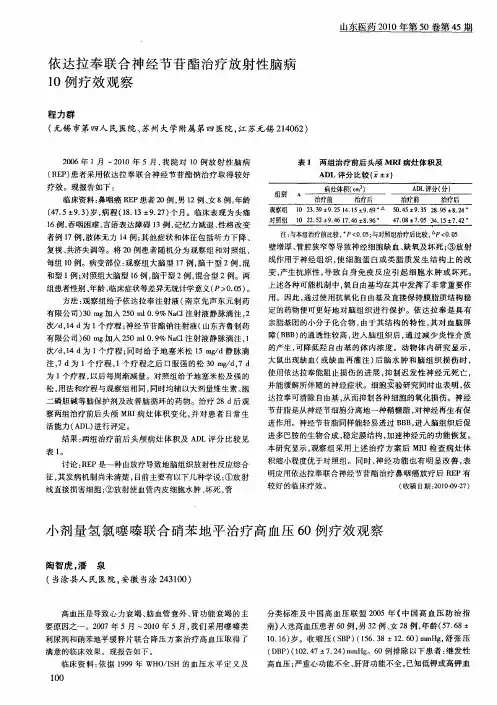
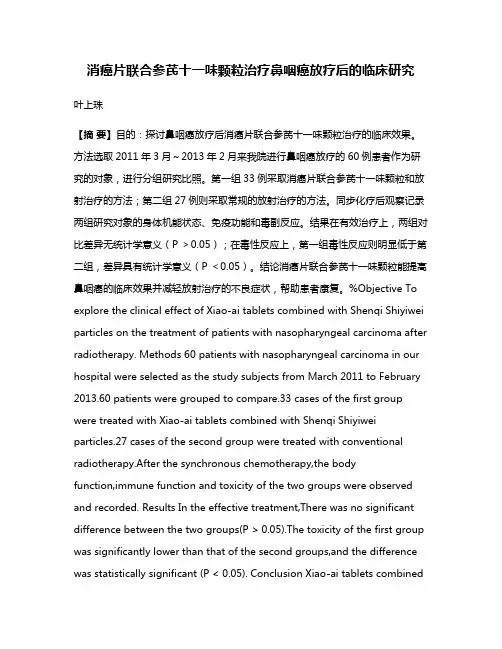
消癌片联合参芪十一味颗粒治疗鼻咽癌放疗后的临床研究叶上珠【摘要】目的:探讨鼻咽癌放疗后消癌片联合参芪十一味颗粒治疗的临床效果。
方法选取2011年3月~2013年2月来我院进行鼻咽癌放疗的60例患者作为研究的对象,进行分组研究比照。
第一组33例采取消癌片联合参芪十一味颗粒和放射治疗的方法;第二组27例则采取常规的放射治疗的方法。
同步化疗后观察记录两组研究对象的身体机能状态、免疫功能和毒副反应。
结果在有效治疗上,两组对比差异无统计学意义(P >0.05);在毒性反应上,第一组毒性反应则明显低于第二组,差异具有统计学意义(P <0.05)。
结论消癌片联合参芪十一味颗粒能提高鼻咽癌的临床效果并减轻放射治疗的不良症状,帮助患者康复。
%Objective To explore the clinical effect of Xiao-ai tablets combined with Shenqi Shiyiwei particles on the treatment of patients with nasopharyngeal carcinoma after radiotherapy. Methods 60 patients with nasopharyngeal carcinoma in our hospital were selected as the study subjects from March 2011 to February 2013.60 patients were grouped to compare.33 cases of the first group were treated with Xiao-ai tablets combined with Shenqi Shiyiwei particles.27 cases of the second group were treated with conventional radiotherapy.After the synchronous chemotherapy,the bodyfunction,immune function and toxicity of the two groups were observed and recorded. Results In the effective treatment,There was no significant difference between the two groups(P > 0.05).The toxicity of the first group was significantly lower than that of the second groups,and the difference was statistically significant (P < 0.05). Conclusion Xiao-ai tablets combinedwith Shenqi Shiyiwei particles can improve the clinical effect of nasopharyngeal carcinoma and reduce the adverse effects of radiation therapy, to help patients with rehabilitation.【期刊名称】《中国医药科学》【年(卷),期】2016(006)022【总页数】3页(P169-171)【关键词】消癌片;参芪十一味颗粒;鼻咽癌;临床研究【作者】叶上珠【作者单位】广东省阳江市中医医院,广东阳江 529500【正文语种】中文【中图分类】R735.1鼻咽癌是危害人体健康的重要疾病之一[1],同时也是医学上的一大难题。
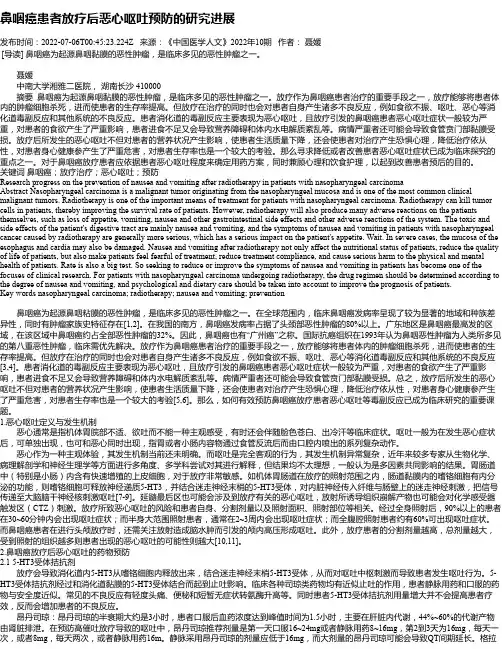
鼻咽癌患者放疗后恶心呕吐预防的研究进展发布时间:2022-07-06T00:45:23.224Z 来源:《中国医学人文》2022年10期作者:聂媛[导读] 鼻咽癌为起源鼻咽黏膜的恶性肿瘤,是临床多见的恶性肿瘤之一。
聂媛中南大学湘雅二医院,湖南长沙 410000摘要鼻咽癌为起源鼻咽黏膜的恶性肿瘤,是临床多见的恶性肿瘤之一。
放疗作为鼻咽癌患者治疗的重要手段之一,放疗能够将患者体内的肿瘤细胞杀死,进而使患者的生存率提高。
但放疗在治疗的同时也会对患者自身产生诸多不良反应,例如食欲不振、呕吐、恶心等消化道毒副反应和其他系统的不良反应。
患者消化道的毒副反应主要表现为恶心呕吐,且放疗引发的鼻咽癌患者恶心呕吐症状一般较为严重,对患者的食欲产生了严重影响,患者进食不足又会导致营养障碍和体内水电解质紊乱等。
病情严重者还可能会导致食管贲门部黏膜受损。
放疗后所发生的恶心呕吐不但对患者的营养状况产生影响,使患者生活质量下降,还会使患者对治疗产生恐惧心理,降低治疗依从性,对患者身心健康参产生了严重危害,对患者生存率也是一个较大的考验。
那么寻求降低或者改善患者恶心呕吐症状已成为临床探究的重点之一。
对于鼻咽癌放疗患者应依据患者恶心呕吐程度来确定用药方案,同时兼顾心理和饮食护理,以起到改善患者预后的目的。
关键词鼻咽癌;放疗治疗;恶心呕吐;预防Research progress on the prevention of nausea and vomiting after radiotherapy in patients with nasopharyngeal carcinomaAbstract Nasopharyngeal carcinoma is a malignant tumor originating from the nasopharyngeal mucosa and is one of the most common clinical malignant tumors. Radiotherapy is one of the important means of treatment for patients with nasopharyngeal carcinoma. Radiotherapy can kill tumor cells in patients, thereby improving the survival rate of patients. However, radiotherapy will also produce many adverse reactions on the patients themselves, such as loss of appetite, vomiting, nausea and other gastrointestinal side effects and other adverse reactions of the system. The toxic and side effects of the patient's digestive tract are mainly nausea and vomiting, and the symptoms of nausea and vomiting in patients with nasopharyngeal cancer caused by radiotherapy are generally more serious, which has a serious impact on the patient's appetite. Wait. In severe cases, the mucosa of the esophagus and cardia may also be damaged. Nausea and vomiting after radiotherapy not only affect the nutritional status of patients, reduce the quality of life of patients, but also make patients feel fearful of treatment, reduce treatment compliance, and cause serious harm to the physical and mental health of patients. Rate is also a big test. So seeking to reduce or improve the symptoms of nausea and vomiting in patients has become one of the focuses of clinical research. For patients with nasopharyngeal carcinoma undergoing radiotherapy, the drug regimen should be determined according to the degree of nausea and vomiting, and psychological and dietary care should be taken into account to improve the prognosis of patients.Key words nasopharyngeal carcinoma; radiotherapy; nausea and vomiting; prevention鼻咽癌为起源鼻咽粘膜的恶性肿瘤,是临床多见的恶性肿瘤之一。
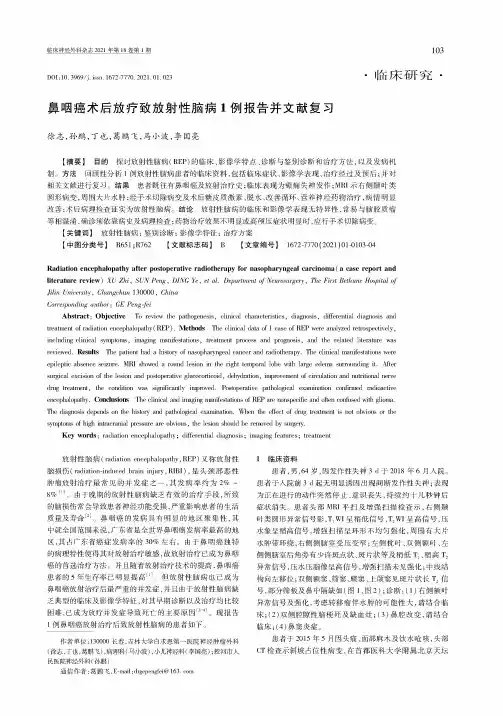
临床神经外科杂志2021年第18卷第1期103 DOP10-3969/j.ion.1672-3770-2021.01.023•临床研究-鼻咽癌术后放疗致放射性脑病1例报告并文献复习徐志,孙鹏,丁也,葛鹏飞,马小波,李国亮!摘要】目的探讨放射性脑病(REP)的临床、影像学特点、诊断与鉴别诊断和治疗方法,以及发病机制。
方法回顾性分析1例放射性脑病患者的临床资料,包括临床症状、影像学表现、治疗经过及预后;并对相关文献进行复习$结果患者既往有鼻咽癌及放射治疗史;临床表现为癫痫失神发作;MRI示右侧颖叶类圆形病变,周围大片水肿;经手术切除病变及术后糖皮质激素、脱水、改善循环、营养神经药物治疗,病情明显改善;术后病理检查证实为放射性脑病$结论放射性脑病的临床和影像学表现无特异性,常易与脑胶质瘤等相混淆,确诊须依靠病史及病理检查;药物治疗效果不明显或高颅压症状明显时,应行手术切除病变。
!关键词】放射性脑病;鉴别诊断;影像学特征;治疗方案【中图分类号】R651;R762【文献标志码】B【文章编号】1672-3770(2021)01-7103-04Radiation encephalopathy after postoperative radiotierapy for nasopharyngeal carcinoma(a case reeort andlite+tu+review)XU Zhi,SUN Peng,DUG Ye,e e al.Depagmenh O Neurosurgery,The Firsp Be t h u ne Hospital o/Jilin University,Changchun130000,ChinaCo g epionding au hog!GEPengjaeiAbstract:Objective To review the pathogenesis,clinOW chaocteWstics,diagnosis,dOferentiO diagnosis andtreatment of radiaVon encephWopathy%REP).Methods The clinOW daW of1case of REP were anWyzed ohospectively,including c/R c/symptoms,imaging maniOstations,treatment process and prognosis,and the related Ueotuo wasreviewed.Reults The patient had a histog of nasophaongeal cancer and odiotheopy.The c/OcW maniOstations wereepileptic absence seizure.MRI showed a round lesion iu the right tempool lobe with large edexix surrounding it.AtersuigcW excision of Ue lesion and postoperaVve glucocoWicoiO,dehydotion,iopovement of circulation and nuthUonW neoodrug heatment,the condiUon was sipnOicantly iopoved.PostopeoVve patholo/cW examinaVon conOioed odioactivo encephlopathy.Conclusions The c/OcW and om/ny manOestaVons of REP are nonspecOo and o/en confuad wiO glioxia.The diagnosis depends on Ue histog and paUolo/cW examinaVon.When Ue eWect of drug hutment is not obvious or Uesymptoms of high inhacraniO pressae we obvious,Ue lesion should be removed by sui/e/\Key wo+s:radiation encephWopathy;ddferential diagnosis;imaging features;treatment放射性脑病(radiation encephWopathy,REP)又称放射性脑损伤(radiation—iduced brain injury,RICI),是头颈部恶性肿瘤放射治疗最常见的并发症之一,其发病率约为2%-8%⑴。
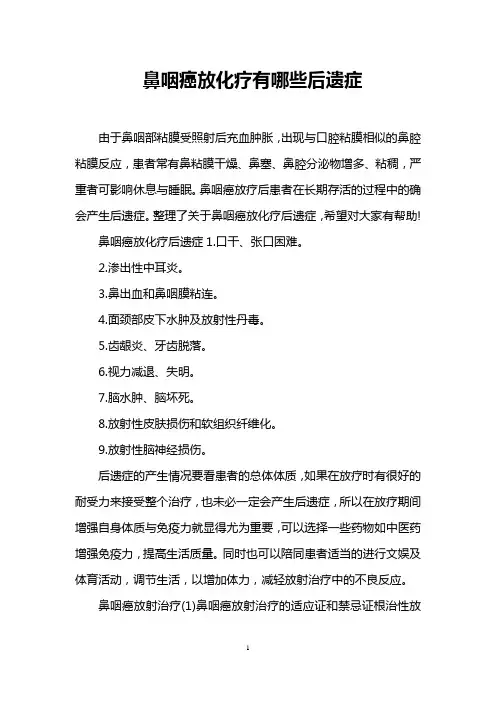
鼻咽癌放化疗有哪些后遗症由于鼻咽部粘膜受照射后充血肿胀,出现与口腔粘膜相似的鼻腔粘膜反应,患者常有鼻粘膜干燥、鼻塞、鼻腔分泌物增多、粘稠,严重者可影响休息与睡眠。
鼻咽癌放疗后患者在长期存活的过程中的确会产生后遗症。
整理了关于鼻咽癌放化疗后遗症,希望对大家有帮助!鼻咽癌放化疗后遗症1.口干、张口困难。
2.渗出性中耳炎。
3.鼻出血和鼻咽膜粘连。
4.面颈部皮下水肿及放射性丹毒。
5.齿龈炎、牙齿脱落。
6.视力减退、失明。
7.脑水肿、脑坏死。
8.放射性皮肤损伤和软组织纤维化。
9.放射性脑神经损伤。
后遗症的产生情况要看患者的总体体质,如果在放疗时有很好的耐受力来接受整个治疗,也未必一定会产生后遗症,所以在放疗期间增强自身体质与免疫力就显得尤为重要,可以选择一些药物如中医药增强免疫力,提高生活质量。
同时也可以陪同患者适当的进行文娱及体育活动,调节生活,以增加体力,减轻放射治疗中的不良反应。
鼻咽癌放射治疗(1)鼻咽癌放射治疗的适应证和禁忌证根治性放疗的适应证全身状况中等以上者;颅底无明显骨质破坏者;CT或MRI 示鼻咽旁无或仅有轻、中度浸润者;颈淋巴结最大直径小于8cm,活动,尚未达锁骨上窝者;无远处器官转移者。
姑息性放疗的适应证肿瘤KSP分级60分以上;头痛剧烈,鼻咽有中量以上出血者;有单个性远处转移者或颈淋巴结转移大于10cm。
经姑息放射后如一般情况有改善,症状消失,远处转移灶能控制者,可改为根治性放射治疗。
放射治疗禁忌证肿瘤KSP分级60分以下;广泛远处转移者;合并急性感染病者;放射性脑脊髓损伤者。
再放疗原则放射治疗后复发再放疗原则,具有下述情况者不宜再放射治疗:同一靶区包括鼻咽及颈部靶区放疗后复发时间未满一;放射治疗后出现放射性脑病或放射性脊髓病;鼻咽部靶区总疗程不宜超过三个疗程,颈部靶区不宜超过两个疗程。
(2)放射线的选择因鼻咽癌原发灶位置深在,周围有重叠的骨质包围,故应选择穿透力强,皮肤量低,吸收少的高能放射源如[60] 钴或直线加速器的高能X线。
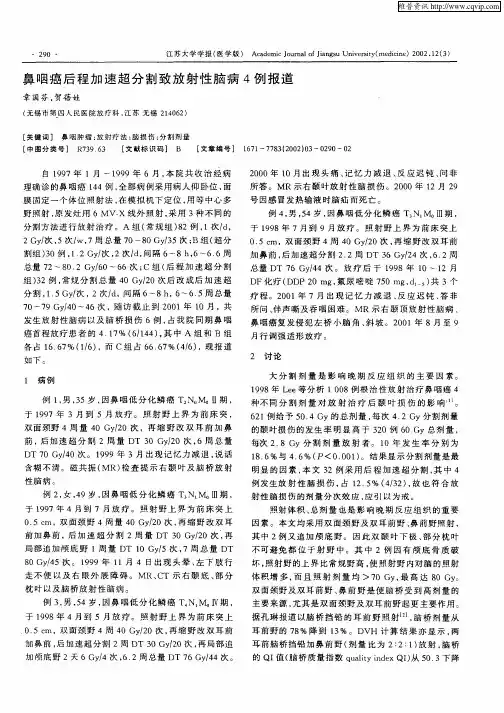

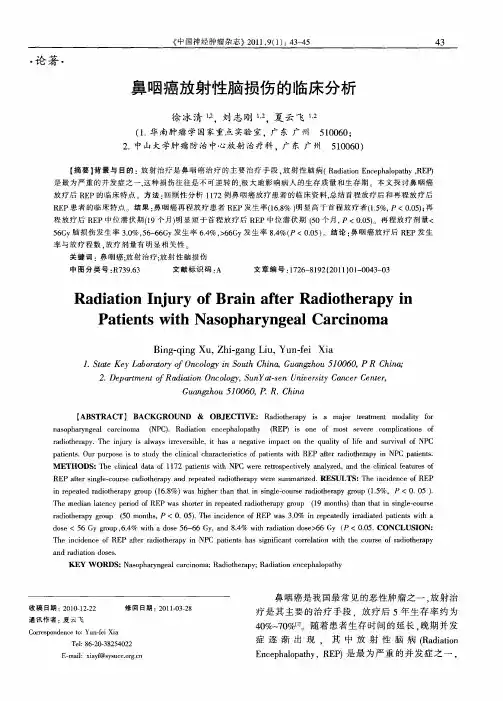
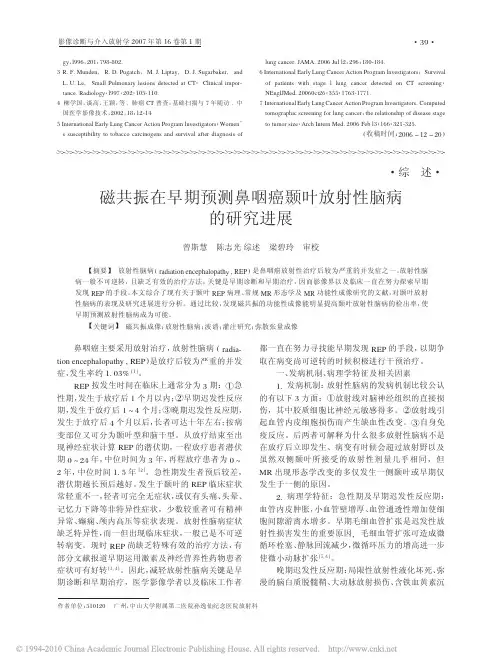

MR波谱对脑胶质瘤术后放疗后复发的鉴别诊断价值刘岚;徐仁根;王索宇;周雪春;孙美;周锋江【摘要】目的探讨MR波谱(MRS)对脑胶质瘤术后放疗后复发的鉴别诊断价值.方法应用GE Singa EXCITE 1.5T HD高分辨磁共振检查仪,对50例脑胶质瘤术后放疗后常规MR检查出现新强化灶的患者行1H-MRS,经再次手术、临床及MR随访综合诊断肿瘤复发23例,放射性脑坏死27例.结果肿瘤复发组(23例)病变强化灶中Cho/NAA、Cho/Cr比值高于放射性脑坏死组(27例),两者比较有统计学差异(P<0.01),而Cho、NAA、Cr含量及NAA/Cr比值两组比较差异无统计学意义(P>0.05).结论脑胶质瘤术后复发灶的Cho/NAA、Cho/Cr指标明显高于放射性脑坏死,对其鉴别诊断具有重要价值.【期刊名称】《实用癌症杂志》【年(卷),期】2013(028)005【总页数】3页(P489-491)【关键词】脑胶质瘤;术后;放射治疗;MR波谱;复发;脑坏死【作者】刘岚;徐仁根;王索宇;周雪春;孙美;周锋江【作者单位】330029,江西省肿瘤医院;330029,江西省肿瘤医院;330029,江西省肿瘤医院;330029,江西省肿瘤医院;330029,江西省肿瘤医院;330029,江西省肿瘤医院【正文语种】中文【中图分类】R739.41脑胶质瘤是1种最常见的脑肿瘤,约占原发性颅内肿瘤的50%,磁共振(MRI)检查是评估脑胶质瘤术后放疗后疗效的主要手段。
脑胶质瘤术后放疗后在临床随访中可能出现3种情况:一是术后放疗后正常改变,二是术后肿瘤复发,三是放疗后正常组织出现放射性脑坏死。
上述第一种情况常规MRI平扫及增强扫描就可以诊断,术区可出现囊腔或脑胶质增生,没有强化病灶;而后2种情况在MRI增强扫描中表现极其相似,均可表现为逐渐增大的不规则强化团块、病灶周围合并水肿及占位效应,难以有效鉴别,诊断偏差导致的治疗错误将会给患者带来严重后果。
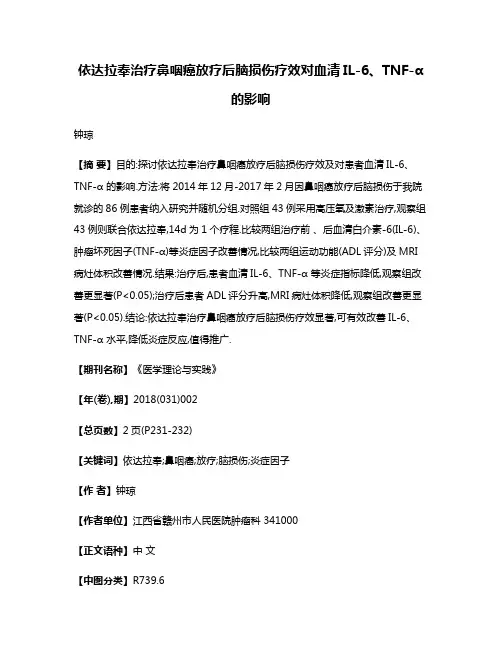
依达拉奉治疗鼻咽癌放疗后脑损伤疗效对血清IL-6、TNF-α的影响钟琼【摘要】目的:探讨依达拉奉治疗鼻咽癌放疗后脑损伤疗效及对患者血清IL-6、TNF-α 的影响.方法:将2014年12月-2017年2月因鼻咽癌放疗后脑损伤于我院就诊的86例患者纳入研究并随机分组.对照组43例采用高压氧及激素治疗,观察组43例则联合依达拉奉,14d为1个疗程.比较两组治疗前、后血清白介素-6(IL-6)、肿瘤坏死因子(TNF-α)等炎症因子改善情况,比较两组运动功能(ADL评分)及MRI 病灶体积改善情况.结果:治疗后,患者血清IL-6、TNF-α 等炎症指标降低,观察组改善更显著(P<0.05);治疗后患者ADL评分升高,MRI病灶体积降低,观察组改善更显著(P<0.05).结论:依达拉奉治疗鼻咽癌放疗后脑损伤疗效显著,可有效改善IL-6、TNF-α 水平,降低炎症反应,值得推广.【期刊名称】《医学理论与实践》【年(卷),期】2018(031)002【总页数】2页(P231-232)【关键词】依达拉奉;鼻咽癌;放疗;脑损伤;炎症因子【作者】钟琼【作者单位】江西省赣州市人民医院肿瘤科 341000【正文语种】中文【中图分类】R739.6放疗是鼻咽癌的主要治疗手段,可有效减小肿瘤体积,预防转移,从而改善预后。
但放疗的同时还可对脑组织造成损伤,即放射性脑病,是鼻咽癌放疗引起的最常见且最严重的并发症。
放射性脑病严重者可影响患者继续治疗,且损伤一旦发生多难以逆转,导致放疗中断甚至危及生命。
资料表明放射性脑损伤发生率为0.9%~4%,已成为影响患者生存质量的重要原因[1]。
炎症因子水平升高与本病的关系已得到多项研究证实,依达拉奉是新型氧自由基清除剂,具有较强的抗炎作用,被广泛应用于脑部炎症性疾病的治疗。
笔者在常规治疗基础上联合依达拉奉效果显著。
1 资料与方法1.1 一般资料将2014年12月-2017年2月因鼻咽癌放疗后脑损伤于我院就诊的86例患者纳入观察,随机数据表法分组。
鼻咽癌病人护理体会(全文完整)鼻咽癌患者放疗的护理体会潍坊市益都中心医院放疗科于秀丽目的:探讨鼻咽癌患者放疗后的护理方法及体会。
方法:放疗前后对患者实施积极的心理护理,放疗后实施饮食护理、皮肤粘膜护理、口腔护理、鼻及鼻咽部护理。
结果:52 例鼻咽癌患者在放疗后有8 例患者出现放射性皮炎,4例患者出现口腔黏膜溃疡,未有患者出现骨髓炎和放射性脑病。
结论:鼻咽癌放疗后并发症较多,应做好积极的护理干预,要求患者合理饮食,注意保护皮肤口腔,保证患者得到良好的恢复。
【关键词】鼻咽癌;皮肤护理;饮食护理;心理护理鼻咽癌是我国常见的恶性肿瘤之一,尤其在我国南方的发病率较高。
放疗是目前治疗鼻咽癌的最有效方法。
但是由于放射性物质持续性的照射患者,容易出现多种急慢性疾病,给患者的身体健康和生活质量带来严重损害。
因此有效的护理干预对改善鼻咽癌患者的生活质量有较大的帮助。
我院2009年6月——2010年3 月对52 例鼻咽癌患者进行综合的护理干预,取得了一定的效果,现将护理体会报告如下。
1 对象与方法1.1 一般资料我院2009 年6 月——2010年 3 月共收治52 例鼻咽癌患者,其中男29 例,女23 例,年龄35-73 岁,平均年龄(56.6±13.2)岁。
低分化腺癌49 例,高分化腺癌2 例,未分化癌1 例。
1.2 放疗方法采用适行调强放射治疗(IMRT)。
1.3 护理干预方法放疗前后对患者实施积极的心理护理,放疗后实施饮食护理、皮肤粘膜护理、口腔护理、鼻及鼻咽部护理,并要求患者定期复查。
2 结果经过积极有效的护理干预,52 例鼻咽癌患者在放疗后有8 例患者出现放射性皮炎,4 例患者出现口腔黏膜溃疡,未有患者出现骨髓炎和放射性脑病。
3 讨论 3.1 鼻咽癌及其治疗鼻咽癌是我国常见的恶性肿瘤,以南方地区发病率较高,男女比例约为2:1,发病年龄一般在30 岁以后,发病原因包括环境、饮食、遗传和EB 病毒感染有关。
鼻咽癌放疗后放射性脑病的研究进展【摘要】 放射性脑病是鼻咽癌放疗后严重并发症之一,认识放射性脑病的发病机理和影响因素、及早地诊断和治疗放射性脑病,对于提高鼻咽癌患者的生存质量有着积极的意义。
近年来,对于放射性脑病的发病机理、影响因素、诊断技术与治疗方法均有很大的进展。
文章就此进行综述。
【关键词】 放射性脑病放疗鼻咽癌放射性脑病(radiationencephalopathy,REP)是鼻咽癌放疗后严重并发症之一,并常常具有不可逆性。
鼻咽癌患者由于预后较好,五年生存率已达40%~70%[1],因而其生存质量值得关注,由于REP严重影响患者的生存时间和生存质量,所以REP已引起临床医生的广泛重视。
现就近年REP在发病机理、影响因素、诊断、治疗等方面的研究进展情况作一综述。
1发病机理REP的发病机理目前尚不完全清楚,一般认为与下列因素有关。
1、1放射线对脑的直接损伤其依据是脑的损伤多发生在放射野内,且以放射野高剂量区最为严重。
Kutita[2]等研究发现成年大鼠脑部放射后8h白质细胞凋亡即达高峰,以少突胶质细胞的凋亡为主,致使少突胶质细胞更新和替代障碍,从而引起脱髓鞘。
但有学者并不认为如此,可能基于以下考虑:(1)REP往往发生在放射治疗后相当长一段时间,而不是放射治疗的当时或随后;(2)病变有时超过放射野。
1、2血管继发损伤血管系统的继发损伤主要表现为血管内皮细胞损伤,血脑脊液屏障破坏和血管性水肿,导致血管管腔狭窄、闭塞或血栓形成,多累及中小动脉,也可累及颈内动脉等大血管,继而引起继发性脑组织缺血、坏死。
Kamiryo 等[2]用辣根过氧化物酶作为示踪剂,电镜扫描脑部经伽玛射线照射的大鼠,发现照射野区域毛细血管网增粗,基膜空泡形成,毛细血管密度低于未照射区且平均管径增大,认为血管改变是放射性坏死的基础。
用血管渐进性病变可以解释REP潜伏期长以及照射区以外脑组织继发性损害的特点。
由于在缺血的部位,伴随着线粒体的电子传递障碍,磷脂酶A2的活性化,产生了花生四烯酸的蓄积,黄嘌呤脱氢酶向黄嘌呤氧化酶转换,从而产生了大量的具有毒性作用的活性氧(reactiveoygenpecie,ROS),尤其是超氧自由基和羟自由基等的细胞毒性的作用[3]。
鼻咽癌放疗后遗症缓解方法(鼻咽癌康复交流中心群:672135491转载修编提示)鼻咽紧邻颅底、脑干、脊髓、眼睛、鼻腔,嗓子,腮腺等重要器官。
淋巴结转移是鼻咽癌最常见的临床表现,约有70%以上的患者是以颈部肿块就诊的,整个颈部淋巴引流区包括咽后淋巴引流区都是鼻咽癌的亚临床区域。
鼻咽癌放疗时照射体积大、放疗疗程长,放射治疗在治疗鼻咽癌的同时,不可避免地损伤正常组织和器官,并发症较多,严重影响患者的生活质量:1................口干。
2................张嘴受限。
3................颈部活动受限。
4................头晕头疼。
5................记忆力下降。
6................牙齿不适。
7................视力下降。
8................听力下降。
9................耳鸣。
10..............鼻塞。
11..............味觉下降。
12..............睡眠质量下降。
13..............骨髓抑制(总体干预)14..............骨髓抑制(白细胞低)15..............骨髓抑制(贫血)16..............骨髓抑制(血小板低)17..............嗅觉下降。
18..............喉咙疼痛。
19..............体力下降易疲劳。
20..............性欲下降。
21..............放射性吞咽功能损伤。
22..............常用功能操和出院后注意事项。
为了提高患者的生活质量,减轻或减少放疗后遗症,正确的处理及放疗后的功能锻炼指导显得更为重要。
鼻咽癌放疗后遗症的防治:1. 口干病因:放射线伤及唾液腺导致唾液分泌减少。
增加舒适度:用润唇膏或石蜡油涂抹口唇,防止干裂增加唾液分泌:1.苦丁茶2.中草药煎茶:玄参、麦冬、生地、金银花、蛇舌草、桔梗、射干、花粉、白术、甘草3.黄芪、枸杞子、金银花、西洋参、白沙参、菊花、麦冬等代茶饮4.嚼甘草、青橄榄、、青果、乌梅、话梅、山楂,吃少量酸性食物,还可以嚼香口胶,促进唾液分泌5.常饮绿茶、柠檬蜂蜜水或石斛、芦根蜂蜜水(石斛煮水后加蜂蜜)6.建议在中医医师指导下,服用既能生津止渴又能提高免疫力的方剂,如陈夏六君子汤加减、生脉汤合四君子汤加减等。